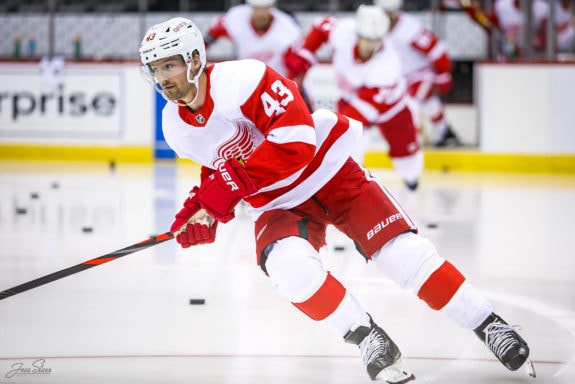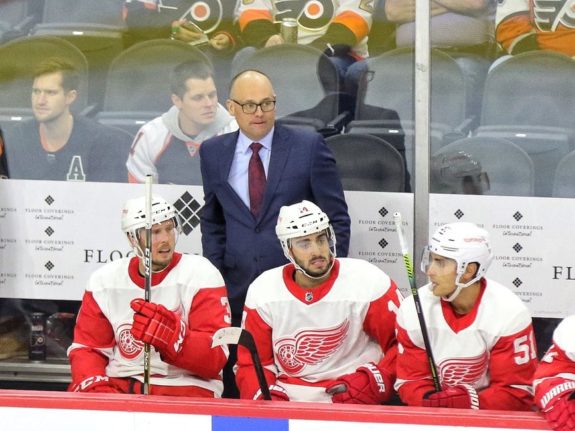The adages can be heard echoing through the empty locker rooms in ice rinks across North America. Clichés such as “play a full 60 minutes,” “the first goal is the most important,” and “work to get the next one,” linger in the air, as heavy as an early morning fog. In the NHL, these phrases are often recycled during media interviews without the player or coach giving them any more than a second notice.
However, for the Detroit Red Wings, these phrases have never been more foretelling than they have throughout the 2020-21 season. While the Wings have been one of the better teams in the NHL when leading after two periods, they have also been one of the worst when trailing heading into the third.

Although the Red Wings are currently tied with the New Jersey Devils for second-fewest goals scored at 79 goals – the Buffalo Sabres have only scored 71 goals – they have been able to close teams out once they get a lead, unlike most other NHL teams.
Play a Full 60 Minutes
When a coach asks a team to “play a full 60 minutes,” they want their players to come out with energy and urgency from the opening puck drop to the final horn. The coach is asking their players to give every ounce of effort throughout every shift they take during the game.
This season, the Red Wings are 7-2-1 when they hold a lead heading into the first intermission. While this stat might not seem that impressive it shows that when the Wings come out with energy and determination in the opening period, they can be good enough to keep other teams from scoring. In the 10 games where Detroit held the advantage after one period of play, only two of those games – an early-season loss and the most recent 4-1 victory over the Columbus Blue Jackets – saw the Wings tied or trailing after the second period.
To drive home the point even further, the Red Wings are 11-0-1 when leading after two periods, good enough for 11th in the league. The .917 win percentage with a lead after two periods of play is the best a Wings team has posted since the 2011-12 season – when Detroit went 48-28-6 as a 5 seed in the Western Conference.

Although the critics will be quick to find reasons to overlook this statistic, the fact that the Wings are able to hold a lead late in a game is a sign this team is on the right track to turning things around.
The First Goal Is the Most Important
Even though the Wings have been at their best over the past five seasons at holding a lead after the first period, they have only managed to tally the first goal in 16 of their first 36 games this season – or 44% of the time. When the Wings scored first they are 9-5-2 for a .563 win percentage. However, when they concede the opening goal in a game, their record nosedives to 3-15-2 for a measly .150 win percentage, seventh-worst in the league.
The Red Wings are currently getting outscored in the first period, 28-35 and have only scored multiple first-period goals in five games, going 4-0-1 when doing so. If the Wings can find a way to start games with more urgency and convert on more chances in the first period, they have a good enough team to shut down opponents the rest of the way.
Work to Get the Next One
Nothing stops a team’s momentum faster than a soft goal taking the wind out their proverbial sail. Little tests of hardship, the game within the game, challenging the mettle of both teams until a victor emerges. Can the team that found themselves behind early claw their way back and overcome the adversity?
In the Wings’ case this season – no.
While they have done exceptionally well at holding onto a lead late in a game, they have been just as bad at trying to recapture one. Detroit is 1-9-2 when trailing heading into the first intermission and 0-16-1 when entering the third period behind on the scoreboard. One obvious, although certainly low-hanging fruit, explanation to this occurrence is coaching – more specifically, Jeff Blashill.

Prior to the Wing’s two-game sweep of the Blue Jackets, Detroit was outscored 12-1 over three games against the Nashville Predators and Dallas Stars. Blashill made one lineup change over the course of those three games – swapping defensemen Christian Djoos and Dennis Cholowski. Even with a lineup of 11 forwards and seven defensemen, in which the coach has more freedom to roll out different line combinations, Blashill remained with the same four lines that were producing zero offensive results. The numbers show that the Wings have the talent to compete and remain in games, even when they are being outplayed, but they will continue to be held back until they get a coach who can do a better job of line matching in-game.
There is a reason that clichés often feel worn out and tiresome. When repeated over and over they begin to lose the power behind their original meaning. Rolling out the same lines night in and night out when the lack of offensive chemistry is in plain view has that same effect. The Wings players continue to show that they have the talent and hunger to speed this rebuild along – if only the coaching staff was able to keep up.